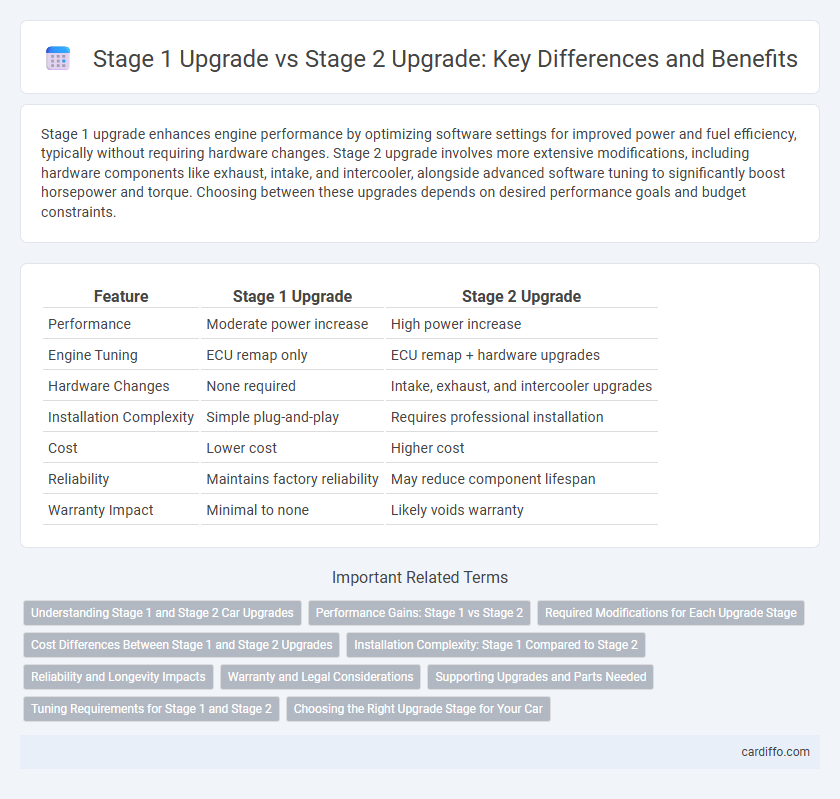Stage 1 upgrade enhances engine performance by optimizing software settings for improved power and fuel efficiency, typically without requiring hardware changes. Stage 2 upgrade involves more extensive modifications, including hardware components like exhaust, intake, and intercooler, alongside advanced software tuning to significantly boost horsepower and torque. Choosing between these upgrades depends on desired performance goals and budget constraints.
Table of Comparison
| Feature | Stage 1 Upgrade | Stage 2 Upgrade |
|---|---|---|
| Performance | Moderate power increase | High power increase |
| Engine Tuning | ECU remap only | ECU remap + hardware upgrades |
| Hardware Changes | None required | Intake, exhaust, and intercooler upgrades |
| Installation Complexity | Simple plug-and-play | Requires professional installation |
| Cost | Lower cost | Higher cost |
| Reliability | Maintains factory reliability | May reduce component lifespan |
| Warranty Impact | Minimal to none | Likely voids warranty |
Understanding Stage 1 and Stage 2 Car Upgrades
Stage 1 car upgrades primarily involve software enhancements, such as ECU remapping, to optimize engine performance without any hardware changes, resulting in improved horsepower and torque within manufacturer safety limits. Stage 2 upgrades combine Stage 1 software tuning with hardware modifications like upgraded exhaust systems, intakes, or intercoolers, delivering significantly higher power gains and better engine cooling. Understanding the differences between Stage 1 and Stage 2 upgrades is essential for selecting the appropriate performance level tailored to driving needs and vehicle capabilities.
Performance Gains: Stage 1 vs Stage 2
Stage 1 upgrades deliver moderate performance improvements by optimizing basic software configurations and minor hardware enhancements, typically boosting system speed by 10-20%. Stage 2 upgrades provide more significant performance gains through advanced hardware replacements and comprehensive firmware tuning, often resulting in 30-50% increased processing power and efficiency. Users seeking maximized output and scalability benefit more substantially from the deeper improvements and improved throughput offered by Stage 2 upgrades.
Required Modifications for Each Upgrade Stage
Stage 1 upgrades require minimal modifications, primarily focusing on ECU remapping to optimize engine performance without altering hardware components. Stage 2 upgrades demand more extensive changes, including the installation of upgraded intake systems, exhaust components, and possibly intercoolers to support increased power output. These hardware modifications are essential to ensure reliability and maximize the benefits of the enhanced ECU tuning in stage 2.
Cost Differences Between Stage 1 and Stage 2 Upgrades
Stage 1 upgrades typically involve software tuning and minor hardware modifications, resulting in lower costs usually ranging from $500 to $1,500. Stage 2 upgrades require significant hardware changes like upgraded turbochargers or intercoolers, increasing costs to approximately $2,000 to $5,000. The higher expense of Stage 2 reflects the comprehensive enhancements for improved performance and durability over Stage 1 modifications.
Installation Complexity: Stage 1 Compared to Stage 2
Stage 1 upgrades involve minimal installation complexity, typically requiring basic hardware changes and simple software configurations that can be completed quickly with limited technical expertise. In contrast, Stage 2 upgrades present higher installation complexity, often demanding extensive system integration, advanced calibration, and in-depth troubleshooting to ensure compatibility and optimal performance. The increased intricacy of Stage 2 installations necessitates specialized tools and experienced technicians to effectively manage the upgrade process.
Reliability and Longevity Impacts
Stage 1 upgrades primarily enhance engine performance by optimizing software settings, improving reliability without significant alterations to hardware components. Stage 2 upgrades involve both software and hardware modifications, such as upgraded intercoolers or exhaust systems, which can increase power output but may introduce higher stress on engine parts, potentially affecting long-term durability. For longevity, Stage 1 is generally safer and better for maintaining original reliability, while Stage 2 requires careful consideration of additional maintenance to sustain engine life.
Warranty and Legal Considerations
Stage 1 upgrades typically maintain the vehicle manufacturer's warranty and comply with standard legal emissions regulations, ensuring no voidance of warranty coverage or legal issues. Stage 2 upgrades, involving more extensive hardware changes such as exhaust or intake modifications, may void warranties and require compliance with stricter emissions laws, potentially leading to legal complications. It is essential to review manufacturer warranty terms and local vehicle modification laws before opting for any stage of upgrade to avoid costly legal and warranty disputes.
Supporting Upgrades and Parts Needed
Stage 1 upgrades primarily support basic performance enhancements requiring minimal parts such as air filters, intake systems, and basic ECU tuning. Stage 2 upgrades demand more extensive supporting components including high-flow exhausts, upgraded intercoolers, and advanced ECU remapping to handle increased power output. Selecting proper supporting parts is essential to ensure reliability and maximize performance gains in each upgrade stage.
Tuning Requirements for Stage 1 and Stage 2
Stage 1 upgrades primarily involve basic tuning requirements such as optimized air intake and exhaust systems, ensuring improved airflow and efficiency without altering the factory engine management. Stage 2 upgrades require advanced tuning adjustments, including ECU remapping and fuel calibration, to accommodate enhanced hardware like high-flow turbochargers and intercoolers. Proper tuning at both stages is critical for maximizing performance gains while maintaining engine reliability and meeting emission standards.
Choosing the Right Upgrade Stage for Your Car
Stage 1 upgrades optimize engine performance using bolt-on modifications without altering the factory ECU, ideal for daily drivers seeking improved power and reliability. Stage 2 upgrades involve comprehensive tuning and additional hardware like upgraded turbochargers or intakes, suitable for enthusiasts aiming for significant power gains and track performance. Selecting the right upgrade depends on your vehicle's current setup, driving goals, and budget constraints.
Stage 1 upgrade vs stage 2 upgrade Infographic

 cardiffo.com
cardiffo.com